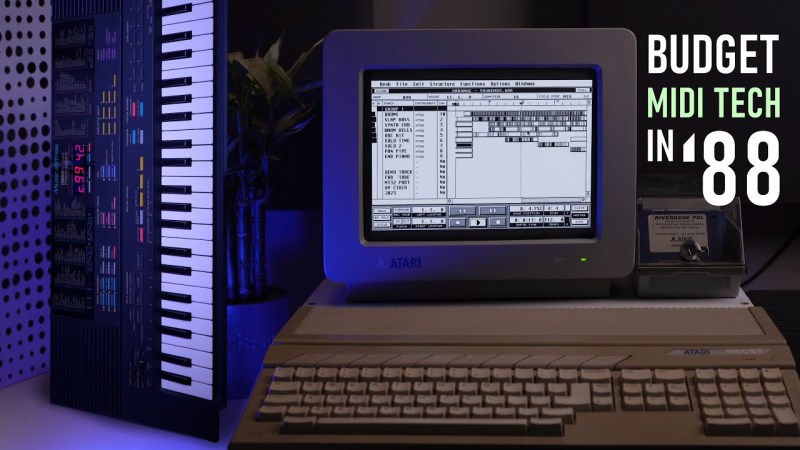These days, there is a plethora of cheap hardware and software which you can use to make digital music. Back in the 1980s, though, this was still a nascent field, with new gear changing the game for musicians. In his latest video, [cTrix] puts together a guide to building a budget MIDI home studio like it’s 1988.
The original Atari ST is the star of the show, which sold for around £300 back then. Unlike most contemporary computers, it came with MIDI ports built-in, and it quickly became a popular platform for music sequencing and controlling external synth hardware. It was often spotted in posh studios being used by big-time musicians, but [cTrix] wanted to look at how it was used by more humble users.
While the Atari ST could output some passable chiptunes, it was most powerful when paired with off-board gear. Industry magazines would readily talk up “DIY” setups worth thousands, but [cTrix] aimed for a budget in the low hundreds. In 1988, that might get you something like the 16-channel Yamaha PSS-580, which rocked full MIDI support and a ton of sounds and drumkits built in. It ran an OPL soundchip, and could play multiple instruments at once under MIDI control from software like Dr. T’s MIDI Recording Studio.
Of course, if you’ve ever played a keyboard like the PSS-580, you’ll have noted that the sound output can be more than a little chintzy. A cheap way to level up was to get yourself something like the Roland MT-32, which rocked a far higher-quality sound module. Everything from slap bass to solid electric pianos could be blasted out from the Roland, which also included a decent reverb unit, too. [cTrix] also dives into other budget heroes, like the rich and expansive Kawai K1 and the Yamaha EMT-10.
If you want to make music like it’s 1988 and you’re hunting for your first gold record, you’ll learn a lot here. We can’t wait for Part 2, that explores the next level of sophistication in this era. His previous lessons on how to make 90s dance bangers on the Amiga are a treat, too.















I came a little later to computer-driven MIDI in 1991 … I’d already picked up a Yamaha V50 synth which supported MIDI and had a built-in sequencer, but lacked the resources to connect it to my frankenstein IBM-PC system. In 1991 I upgraded to an IBM L40SX laptop, and bought a Yamaha TG100 tone generator – it was a good sound upgrade, and the TG100 featured a serial-port host interface that would let you communicate not just with the module but also (in limited fashion as I recall) with its MIDI ports. Really boosted my music production, and just got better when I added Yamaha’s beast of a controller, the KX88. Eventually upgraded to an early Thinkpad with a PCMCIA interface that supported MIDI “natively” (over the game controller dongle!) and was able to take it reliably on the road for gigs. That also gave me the option of steering MIDI music from games out to the TG100, which was way better than the on-board synths. :-)
I still have the V50, KX88, and the TG100 – they’re not my daily drivers anymore (although the KX88 was up until just a few years ago), but they really held up well.
Definitely check his video about audio sampling on Amiga as mentioned in TFA.
He’s got an album he released a few years ago called “A for Amiga” that is absolutely worth a listen.
AtariST was very popular for MIDI sequencing for a long time due to it’s stability. I remember around 1999 one professional music magazine recomended it as a cheaper option than Mac but more reliable than Windows. Fatboy Slim was using it untill around 2012 (https://www.musicradar.com/news/tech/interview-fatboy-slim-on-going-digital-as-a-dj-and-as-a-producer-546858).
I can’t watch the video but I will soon – I never had that gear and would like to see how ergonomic this set up was.
by the way – in 1989 Cubase was released for Atari which for many years was a standard studio software.
DeVry Institute of Technology (merged with Keller Graduate School in 2002 to become DeVry University) used to offer a course in digital music which included an Atari ST, a MIDI keyboard, and the software.
When the ST was no longer available DeVry switched to an IBM desktop with a Soundblaster and MIDI adapter to go with the keyboard.
I had a very similar back then where I spent gobs of money on. I had an Atari 520st, Sequential Circuits 6 track, BitOne keyboard. I used Cakewalk and Cubase on the Atari.
Lacking any musical ability, any keyboard would be a waste of money and space.
MIDI itself, however, should allow even someone as clueless as me to compose a tune, given an appropriate file editor.
Getting it to sound GOOD will have to wait for articles about DAW and VST plugins, I suspect.